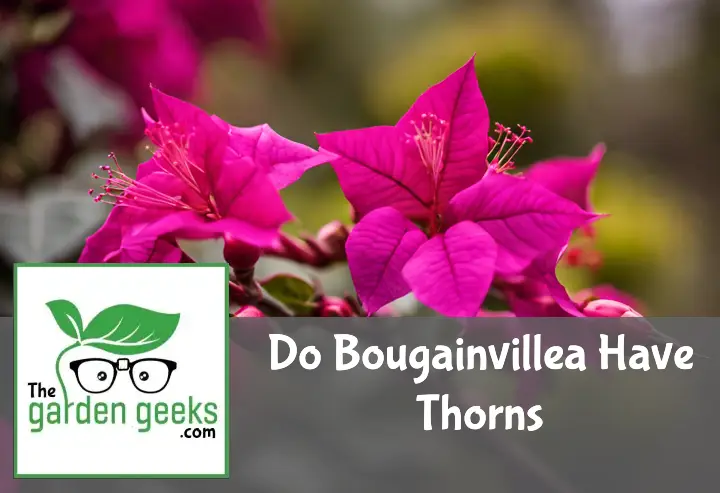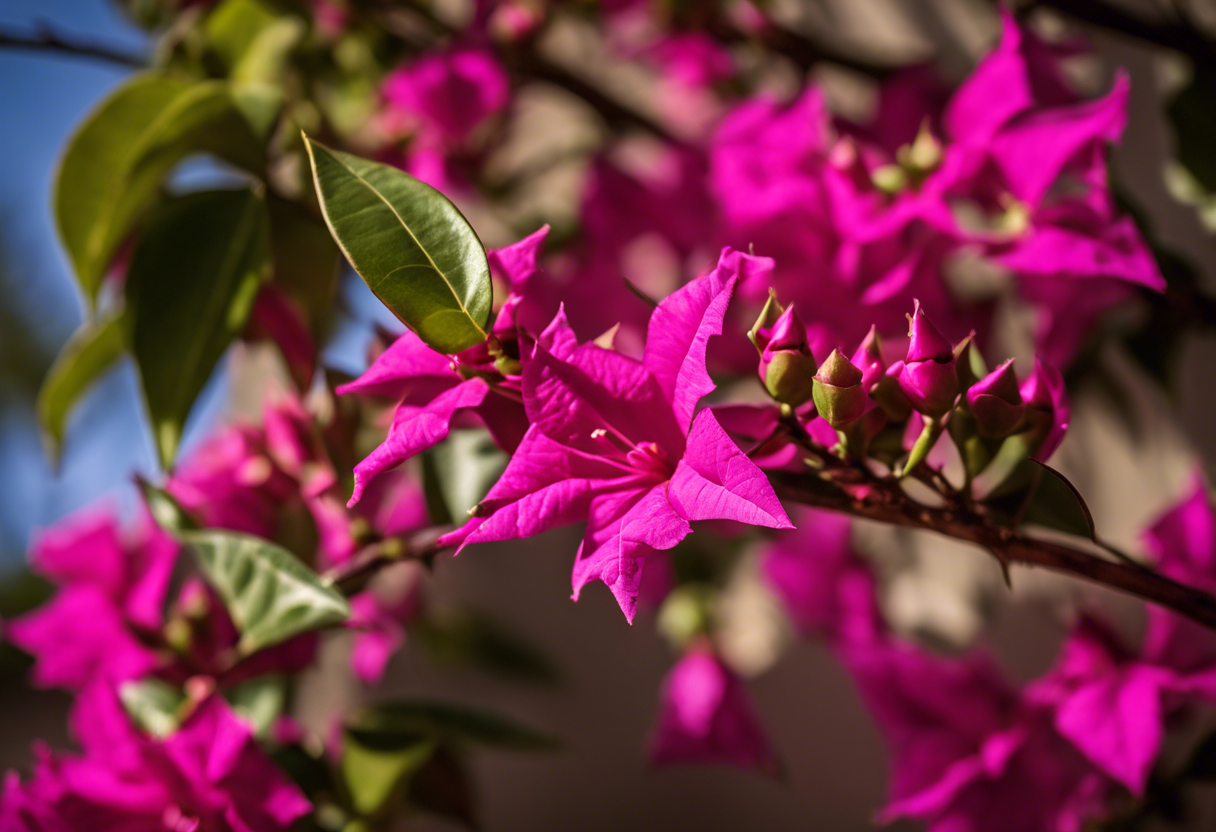Ever found yourself strolling through a garden, admiring the vibrant hues of Bougainvillea, only to be pricked by an unexpected thorn? If so, you’ve probably wondered, “Do Bougainvillea Have Thorns?” Spoiler alert – they do! But why would such a beautiful plant need to arm itself with prickly defenses?
These gorgeous plants are more than just a pretty face. Their thorns serve a purpose, acting as their little bodyguards. They’re like the bouncers at a nightclub, keeping unwanted guests out. So next time you get pricked, remember it’s just the Bougainvillea looking out for itself! Keep reading about ‘Do Bougainvillea Have Thorns?’
Key Takeaways
- Yes, bougainvillea plants do have thorns.
- The thorns are sharp and can grow up to 2 inches long.
- They are located along the branches and are typically hidden by the leaves and colorful bracts.
- The plant uses these thorns as a climbing aid and for protection against herbivores.
- Care should be taken when handling or pruning bougainvillea due to these thorns.
Do Bougainvillea Have Thorns?
Well, to answer the question “Do Bougainvillea Have Thorns?” in a nutshell, yes they do! The Bougainvillea plant characteristics include vibrant flowers and, you guessed it, thorns. But don’t let that prickly detail deter you from appreciating these beauties.
The Anatomy of a Bougainvillea Plant
The structure of Bougainvillea is quite fascinating. It’s like the botanical version of a superhero – stunningly beautiful yet tough as nails. The thorny aspects of Bougainvillea are one such feature that adds to its resilience.
These thorns, found along the vine stems, aren’t just there for show. They’re sharp and sturdy, ready to protect the plant from any potential threats. So while we admire the physical features of Bougainvillea, remember to approach with caution!
Understanding the Purpose of Thorns in Bougainvillea
Now you might be wondering, “Why do bougainvilleas have thorns?” Well, it’s all about survival in the plant world. The functionality of thorns in Bougainvillea serves as a defense mechanism against hungry herbivores looking for a leafy snack.
But that’s not all! These thorns also help bougainvilleas climb and spread over surfaces by providing grip and support. So next time you see those spiky protrusions on your bougie (that’s slang for bougainvillea), remember they play an important role in the bougainvilleas’ survival strategy!
What are the Characteristics of Bougainvillea Thorns?
Let’s delve into the nitty-gritty of bougainvillea thorn characteristics. These prickly guys aren’t just there for show, they’ve got some interesting features that make them a unique part of the plant.
Size and Shape of Bougainvillea Thorns
When it comes to the size of bougainvillea thorns, they’re not messing around. These bad boys can grow up to an inch long! They’re sharp, pointy, and shaped like a cat’s claw – hence their nickname, “cat’s claw.”
But don’t be fooled by their menacing appearance. The structure of bougainvillea thorns is actually quite fascinating. They’re firm but flexible, allowing them to withstand various weather conditions without breaking.
Location of Thorns on the Plant
Now let’s talk about where these spiky fellas hang out on the plant. You’ll typically find thorn location on bougainvilleas along the branches and stems.
However, they’re not randomly scattered about. Nope, these thorns have a strategic placement – usually at the base of leaf clusters or flower bracts. This prime position allows them to serve as a protective barrier against hungry critters who might fancy a nibble on those beautiful blooms.
So next time you’re admiring a bougainvillea, remember – those thorns aren’t just there for decoration. They’re an integral part of this plant’s survival strategy in its natural habitat!
How to Handle Thorny Bougainvilleas Safely?
When it comes to bougainvillea care, safety is paramount. Those pretty blossoms can fool you, but remember, Do Bougainvillea Have Thorns? Oh yes, they do! So let’s talk about how to handle these prickly beauties without turning your gardening session into a thorny nightmare.
Protective Gear for Handling Thorny Plants
First things first, gear up! You wouldn’t go into battle without armor, right? Same goes for tackling thorny plants like bougainvilleas. Start with protective gloves for gardening. They’ll keep those sneaky thorns from pricking your fingers.
Next up, consider thorn-proof clothing. A sturdy long-sleeved shirt and pants will shield your skin from unexpected scratches. And don’t forget about your feet! Sturdy footwear for gardening is a must to avoid any unpleasant surprises lurking in the soil.
Lastly, protect those peepers with some safety goggles for pruning. Flying debris is no joke when you’re snipping away at branches. For extra protection, a face shield for plant care isn’t a bad idea either.
Safe Pruning Techniques for Thorny Plants
Now that we’re all suited up, let’s dive into the nitty-gritty of safe pruning techniques. First off, timing is everything when it comes to bougainvilleas. The best time to prune bougainvillea is after their blooming cycle when the plant’s growth slows down.
Using the right tools also plays a crucial role in avoiding injury while pruning. Opt for sharp and clean tools specifically designed for handling thorny plants. Remember folks; dull tools are more dangerous than sharp ones!
Lastly, don’t forget about proper disposal of pruned branches. Those trimmed twigs can turn into a prickly problem if not handled correctly. So, wrap them up safely before tossing them in the green bin.
And there you have it! With these safe pruning methods, you can keep your bougainvillea looking beautiful without any thorny troubles. Happy gardening, folks!
Can You Find Thornless Varieties of Bougainvillea?
Well, here’s the scoop. Yes, there are thornless varieties of bougainvillea out there! This is great news for those who love the vibrant colors of these plants but not so much their prickly nature. So, if you’re wondering “Do Bougainvillea Have Thorns?“, the answer is usually yes, but not always!
Popular Varieties of Thornless Bougainvilleas
Now let’s talk about some popular thornless Bougainvillea types. First up is ‘Miss Alice’, a white-flowered beauty that’s as gentle as she sounds. Then we’ve got ‘Singapore Pink’, a soft-pink variety that won’t poke you when you go in for a sniff.
Another one to look out for is ‘Silhouette’, an attractive thornless flower with lavender blooms. And last but not least, ‘Helen Johnson’ – a coppery pink lady that’s known to be less spiky than most.
Care Tips for Thornless Bougainvilleas
Caring for these thorn-free plants isn’t too different from their pricklier cousins. They need plenty of sun and well-drained soil to thrive. Water them thoroughly but infrequently, allowing the soil to dry out between waterings.
Pruning can be done after flowering to maintain shape and promote more blooms. Just remember, even though they’re thornless, it doesn’t mean they don’t need love and care! With these tips in mind, your Bougainvillea should bloom beautifully without giving you any sharp surprises!
To Wrap Up
So, the answer to the question “Do Bougainvillea Have Thorns” is a resounding yes! They’re like the porcupines of the plant world, pretty but prickly.
Remember, gardening isn’t just about roses and rainbows. Sometimes, you’ve got to tackle those thorny issues too. Happy pruning!



